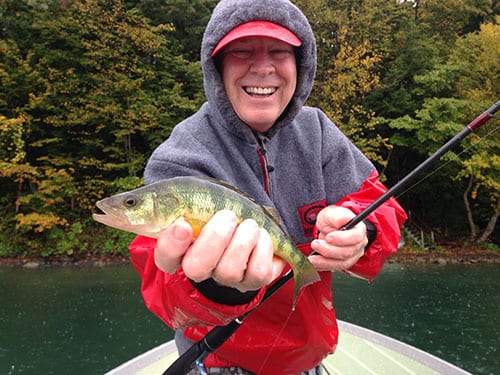
By Tom Schlichter
Conventional wisdom advises sweet water anglers to look deep as water temperatures drop through the fall. In many waters, this makes perfect sense as chilly weather prompts both baitfish and predators including bass, pickerel, walleye, perch and panfish, to slide out from shore to depths that have relinquished less of their warmth.
But what about those dishpan lakes and ponds? Oftentimes, favored local bass, pickerel and panfish haunts are shallow basins covering 10, 20 or 30 acres while maxing out no deeper than 6 to 10 feet. Some anglers believe the fish simply go dormant in such environs once winter begins to take hold. I assure you that is not the case. Fact is, after all the weeds die back and shoreline growth drops its leaves, such waters may be easier to fish now than they were during the heat of summer.
AFTERNOON SURVEYS
One way to connect with predators in skinny water lakes and ponds long after the swimsuit season has come and gone is to slowly troll across the flats. It’s a technique that produces quality fish on a routine basis and sometimes works throughout the day. The keys to success are quite simple: troll slowly, use ultralight tackle, and scale down the size of your shallow running plugs.
I focus most of my efforts on trolling for largemouth bass, crappies and chain pickerel, but the same technique works with walleyes, trout, smallmouth bass and, especially, big yellow perch if they inhabit the waters you prospect. To sample this technique, pick a late afternoon after the water has had time to reach its maximum temperature for the day. Dedicate an hour or two to simply covering potentially productive water, making several passes in any area where you hook-up before moving on to prospect further.
The idea of this initial surveying is to map out the hot spots by covering a lot of water, and then eliminate unproductive areas to maximize the time your lures will be passing through the strike zone. Mostly, I’ll troll along the sunny side of shadow lines or parallel contour breaks where the water drops off from one or two feet deep to four- or five-foot depths. I’ll also take a pass or two along any sharp phragmite or cattail wall that stands in two or three feet of water.
Some days, I’ll troll by kayak, being sure to keep my paddle strokes quiet, gentle and just fast enough to keep moving. In my john boat, I’ll put my tolling motor to the slowest setting that keeps me moving steadily into the wind and adjust the speed to slow down slightly should my path eventually put the wind at my back. Either way, it’s a good idea to wear a life vest this time of year if you head out in a small vessel – in some areas, it’s required.

LIGHT RODS AND SMALL LURES
Top choices for slow trolling include small floating or sinking Rapala, Rebel and Yo-Zuri plugs. Work these from an ultralight set-up with 4- to 6-pound-test line. Lure size should be two-and-a-half to 4 inches. Black and silver, gold, white and sky blue have been my most productive late fall patterns. In waters where toothy pickerel are a possibility, or if I suspect that large walleye or lunker largemouths may be encountered, tying on a 30-inch leader of 8- to 12-pound-test mono adds a little protection. Connect the leader with a black barrel swivel and you’ll gain an extra few inches of depth for your lures.
Using this set-up, it is possible to troll floating/diving lures 6- to 12 inches below the surface at a gentle pace. On many shallow lakes and ponds, that’s just enough to glide above submerged weed beds. To work deeper, select a sinking plug and you should be able to get down 3 to 4 feet.
RECONNAISSANCE FOR NEXT YEAR
Slow trolling in skinny water works particularly well on the sunny side of a lake or pond, and in waters where you can get up close to the inflow from a stream or brook. It can also be quite productive when used to work those same weed-choked flats that are so difficult to penetrate in the summer. Be aware that this isn’t the kind of technique where you’ll hammer fish after fish, as you might if jigging tightly schooled bass and panfish in deeper lakes – but you’ll likely be pleasantly surprised at the size of some of the fish that attack your offerings, along with the steadiness of the action.
Keep in mind as you make your way around a favorite lake or pond that an added benefit of slow-trolling during fall and winter is that the gin-clear water allows a thorough inspection of the bottom. Using a pair of polarized sunglasses you’ll be able to spot submerged rocks, timber, wrecks, ridges, humps, slopes and ledges. All are potential hot spots come next spring.









